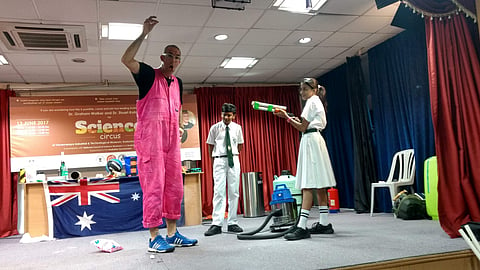

For hundreds of students who made a visit to the Vishvesvaraya Industrial and Technological Museum in Bengaluru, their classroom science was taught in a fun way, thanks to two scientists from Australia who conducted a number of experiments for them.
It was a Tuesday morning. On usual days, these Primary and High School students from various schools would be attending a theory session on science. This one, however, was different. Be it Newton's laws or an explanation of kinetic energy, it was an experience they would remember. Concepts that are ordinarily taught in class, were put in the form of practical experiments for them.
A simple reaction such as soda being mixed with Vinegar was converted into a fun-to-learn experiment with just a jar and it's lid. On combining the two, the lid was thrown into the air leaving students surprised. This was not it. Experiments with nitrogen that propelled a car had the students in awe.
For Graham Walker and Stuart Kohlhagen, both, faculty at the Australian National University, it is their passion to ensure science reaches all students. More importantly, the duo are on a mission to make it fun for them to learn it.
The first of a series of workshops that these scientists would conduct across India was held in Bengaluru in association with the Australian Consulate. The same is also funded by the National Council of Science Museums.
The duo hopes to cover over 15,000 students in the next ten days, covering 14 cities across the country.
Dr. Walker explained that they had covered several countries teaching science to students from schools. "It started off as a small idea conceptualized by Professor Michael of the Questicon. It began with the creation of a museum for children to make it easy for them to understand science. However, a few years down the line, he realised that it would not be enough to reach all," he explained.
What started off as an idea conceptualized into a project that the Australian Government started funding. "I have covered 15 countries so far, reaching out to a lot of children," he said.
Even as Walker and Kohlhagen carry a set of essentials with them for the experiment, they have a list of items that they seek the National Council for Science Museums to shop for them. Kohlhagen believes that it is important to reach out to young students and hence explained that their focus was on students.
Speaking about his experience in Bengaluru, he added, "We have traveled across countries. However what we appreciate about the Indian students is that they are here not just to enjoy the experiments but also to learn and take home the message."
The duo also added that they have had teachers request them to conduct experiments that are in line with the syllabus. "What we do is not teach the students what is already there in their syllabus. It is only supplementing their classroom learning," Dr Walker mentioned.
These scientists who have dedicated their undivided time to the programme said that they take ideas from classroom teaching to nurture creativity among students. Even on Tuesday, the programme began with a brief interaction with students on what was being taught in class.
